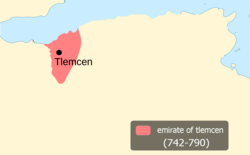Emirate of Tlemcen
| Emirate of Tlemcen | |||||||||
|---|---|---|---|---|---|---|---|---|---|
| 736–790 | |||||||||
 Flag | |||||||||
 Emirate of Tlemcen around 742-790 | |||||||||
| Status | Emirate | ||||||||
| Capital | Tlemcen | ||||||||
| Common languages | Berber, Arabic | ||||||||
| Religion | Sufri Islam | ||||||||
| Government | Emirate, tribal confederacy | ||||||||
• Until 790 | Abu Qurra | ||||||||
| History | |||||||||
• Revolt against the Umayyads | 736 | ||||||||
• Establishment | 742 | ||||||||
• Annexed by the Rustamids | 790 | ||||||||
| |||||||||
| Today part of |
| ||||||||
Part of a series on the |
|---|
| History of Algeria |
 |
|
|
|
|
Modern times |
|
|
The Ifranid Emirate of Tlemcen[1] or Ifranid Kingdom of Tlemcen,[2][3][4] was a Kharidjite state,[5][3] founded by Berbers, of the Ifranids, in the central Maghreb in the eighth century,[6] whose capital was Tlemcen in modern Algeria.[6]
History
After the Muslim conquest of the Maghreb, the Berbers revolted against the Umayyad caliphate. These revolts were associated in the middle of the eighth century with Kharidjite teachings, which won over a good part of the Maghreb with its puritanism and egalitarian message.[7] Thus, the first Muslim states in North Africa were Kharidjites. In the central Maghreb, the Rostemides founded a kingdom with a capital at Tahert. Around the same time, Abu Qurra, head of the Ifren tribe, created a Sufrite kingdom near Agadir (former name of Tlemcen) André Julien mentions: "The internal life escapes us, but whose military role was considerable".[2]
During the revolt of the Zenata tribe of the Ifranides, they proclaimed their leader Abu Qurra Caliph, and he settled in Tlemcen.[7][8] The creation of this city is attributed to Ifranides, but the site was already occupied by the Roman city of Pomaria.[6] In 767, united with the Kharidjites of Tahert and Nafusa Mountains, Abu Qurra launched an expedition east and surrounded the Abbasid governor in the fortress of Tobna in the Aures and reached Kairouan.[8] Back in Tlemcen, he allied himself with the Maghraouides and had to confront the expansionist aims of the Idrissides.[7][8] However, the caliph sent a strong army from the East under the new governor, Yazid ibn Hatim al-Muhallabi, who defied the Kharidjites in Ifriqiya, but the rest of the Maghreb escaped the authority of Baghdad.[7][2]
Abu Qurra could not allow his descendants to found a dynasty.[9] The kingdom did not last long, in accordance with the strict rules of Sufrites. He welcomed with open arms Idris I, whose kingdom he recognized and thus broke with the Rostemides. Idris I negotiated with the Maghrawas the handing over of the city of Tlemcen, and then one of his descendants, Muhammed Sulayman, created in the region the "Sulaymanid kingdom", a state that seemed to control the cities and which ended under the Fatimids in 931.[10]. Tlemcen became a distinguished city, growing in connection with the Arab culture of Al-Andalus, but in the countryside, Ifranides retained their heterodoxy. In 955 their leader Yala Ibn Mohamed revolted against the Fatimids.[10]
See also
Bibliography
- Gilbert Meynier (2010). L’Algérie, cœur du Maghreb classique: De l’ouverture islamo-arabe au repli (698-1518) (in French). Paris: La Découverte. ISBN 9782707152312.
- Philippe Sénac (21 September 2011). Le monde musulman: des origines au Xe siècle (in French). Armand Colin. ISBN 9782200274139.
References
- ↑ Philippe Sénac; Armand Colin (2011). Le monde musulman: des origines au Xe siècle [The Muslim World: From Its Origins to the 10th Century] (in French). p. 177 – via Google Books.
- 1 2 3 Charles-André Julien (1994). Histoire de l’Afrique du Nord: Des origines à 1830 [History of North Africa: From Its Origins to 1830]. Paris: Édition Payot. pp. 365–366. ISBN 9782228887892.
- 1 2 Alain Romey (1982). Histoire, mémoire et sociétés: L'exemple de N'goussa: oasis berbérophone du Sahara (Ouargala) [History, Memory and Societies: The Example of N'goussa: Berber-speaking Oasis of the Sahara (Ouargala)]. University of Tunis.
- ↑ Chems Eddine Chitour (2004). Algérie: le passé revisité [Algeria: The Past Revisited]. Casbah Editions. p. 51. ISBN 9789961644966.
- ↑ Leïla Babès (2011). L'utopie de l'islam: La religion contre l'État [The Utopia of Islam: Religion Against the State]. Armand Colin. p. 122.
- 1 2 3 C. Agabi (2001). Ifren (Beni). Encyclopédie berbère. 24. Edisud. pp. 3657–3659.
- 1 2 3 4 Gilbert Meynier (2010). L’Algérie, cœur du Maghreb classique: De l’ouverture islamo-arabe au repli (698-1518) [Algeria, Heart of the Classical Maghreb: From the Islamo-Arab Opening to the Retreat]. Paris: La Découverte. p. 25. ISBN 9782707152312.
- 1 2 3 (Meynier 2010, p. 27)
- ↑ Mohamed Talbi (1982). Dirasat fi tarij Ifriqiyya wa-fi al-hadara al-islamiyya fi al-'asr al-wasit (in Arabic). University of Tunis. p. 58. Retrieved January 1, 2018 – via Google Books.
- 1 2 (Meynier 2010, p. 28).